Beautiful Plants For Your Interior
Gardening Month by Month – April
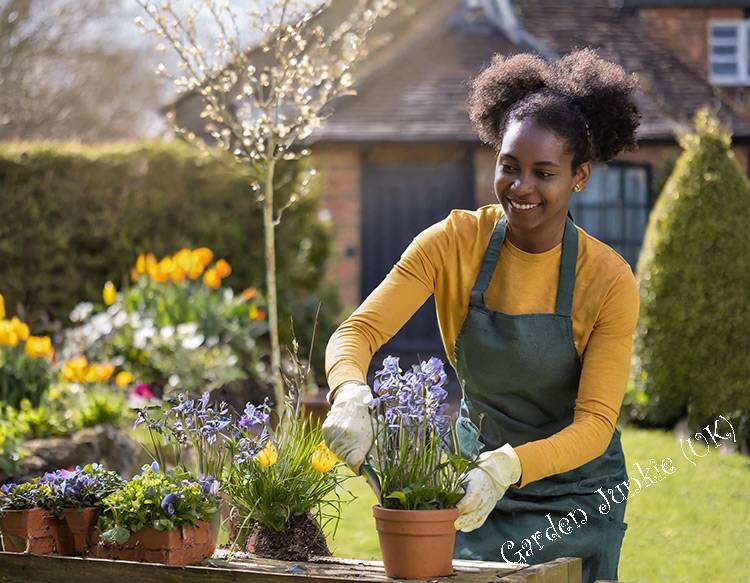
Choose Your Gardening Month by Month –
Gardening Month by Month – We continue this month (April) with our regular monthly gardening section centred on our practical informative ‘gardening’ checklists. This page Gardening Month by Month – April and our other similar monthly pages offer multiple reminders and ‘helpful tips’ to assist you with various gardening tasks throughout the year, including tending to your garden, allotment, greenhouse, pond, and general garden maintenance.
Many of these gardening activities are best suited for a specific month or months. Let’s look at what tasks require your focus in and around the garden during April.
Gardening Month by Month – April
April is a bustling time for gardeners, allotment enthusiasts, and greenhouse keepers as the arrival of spring brings a surge of activity in our outdoor spaces. This time of year marks the beginning of a vibrant and productive season for all those passionate about gardening and nurturing plant life.
Pond owners can if needed, may want to start dividing and replanting waterlilies or adding algaecide in April, as this is the best time to add algaecide to prevent a pond’s algae growth. Although you can add it at other times of the year.
Checkout Our April Gardening Checklist:
April can herald the ‘blooming’ of a wide array of flowers, like daffodils (Narcissus pseudonarcissus), primroses (Primula vulgaris), tulips (Tulipa spp), rhododendrons (Rhododendron arboreum), marsh marigolds (Caltha palustris) and foxgloves (Digitalis purpurea) which all bloom in April. All adding vibrant splashes of colour and fragrance to the landscape.
Allotment holders may also be busy tending to early crops like ‘broad beans’ and preparing the soil for vegetables like runner beans, making it ready for a bountiful growing season.
Those greenhouse owners are certainly busy nurturing and ‘pricking’ out tender seedlings and transplanting young tomato plants for example, from their sheltered greenhouse environment to their final grow bags.
Generally, you should have finished ‘preparing’ your soil over these last months, so now it’s the perfect time to sow a variety of seeds. With longer and warmer days, this month is ideal for making initial sowings of certain seeds outdoors, while others can be started indoors and later transplanted once the threat of frost has subsided. So a lot to do; so let’s take a look at what can be done.
In April: Garden, Allotment, Flowers, Greenhouse.
- If you are looking to ‘sow’ flower seeds directly outside in the garden, then April is a good time to start.
- Fill hanging baskets and pots with summer bedding plants, but keep them indoors until you are sure the final frosts have passed.
- Depending on location, sow Sunflowers (Helianthus spp.) under glass or after the last frosts. Sunflowers will provide you with a great summer bloom going on into autumn.
- A popular ‘bedding’ flower to sow for a June-September bloom is the ‘scented’ Sweet alyssum (Lobularia maritime). These can be sown directly where they are to flower, later in the month or undercover at any time in the month of April. Ensure they are sited in well-drained soil and full sun or light shade. Alyssum is a great ‘pollinating plant’ suitable for insects like bees and other beneficial insects that help control pests.
- Another popular flower to plant out this month is the ‘Dahlia’ (Dahlia pinnata). April is a great month to plant these ‘tubers’ out ensuring you get a vivid bloom from July until the first frost, which is usually around October or November.
- Its April! then the ‘weeding’ season has arrived once again with the onset of spring, bringing along the inevitable growth of weeds. By taking early action while the annual weeds are just beginning to sprout, you can effectively eliminate them while they are still small, significantly minimising the amount of weeding required later in the year.
- One thing that is certainly beginning to grow this month is the ‘lawn’. Start with a once-a-week ‘high’ cut when the grass is dry. Gardeners should try and mow lawns at least “once a week” in April to keep grass “healthy”. Give your lawn a light ‘April’ shower watering twice a week.
- April is a good time to apply fertiliser, lay turf and or re-seed your lawn. If your lawn has bare patches, reseeding in April is the best solution to address this issue.
- Prick out your seedlings that were sown last month in the greenhouse or indoors if ready, and ‘pot them up’.
- Before flowers like Peonies and other perennials get too big, ensure you provide plenty of support for them.
- Plant out autumn-sown sweet peas, freesias, ixia, Shasta daisies, lupins, and any other perennial and annuals.
- To promote the growth of ‘fuchsia’ plants during the summer, it is recommended to plant them now this month.
- Don’t forget to apply well-rotten manure around perennials and biennial plants ahead of the hot weather.
- If any plants in your garden still face the risk of being damaged by frost (depending on location and local weather). It’s important to take steps to protect them in advance, such as applying mulch to shield the delicate plants. Mulching will aid in maintaining a slightly warmer temperature in the soil.
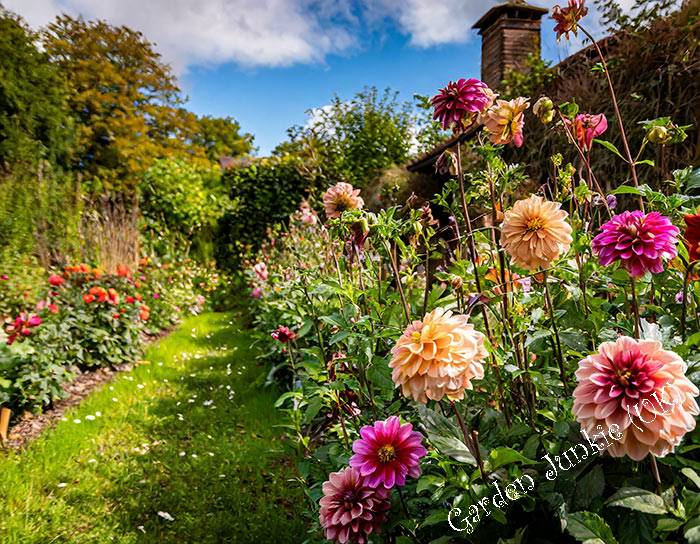
Gardening Month by Month – April: Dahlias Tubers Can be Planted Out This Month to Ensure a Vivid Summer Bloom From July.
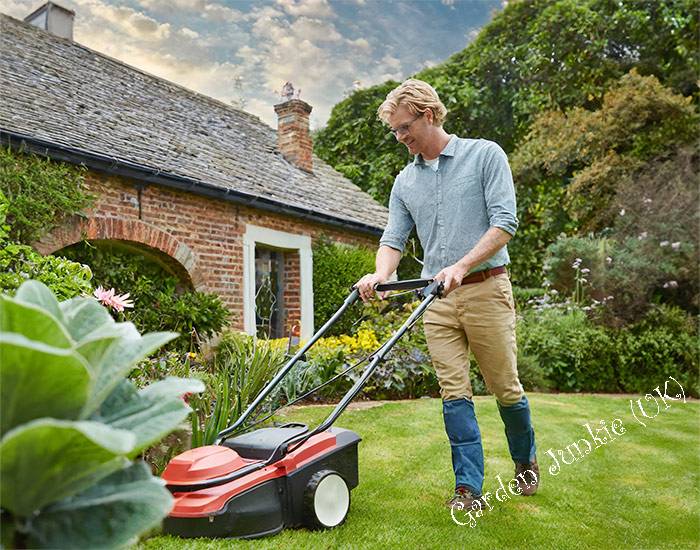
Gardening Month by Month – April: Start With a Once a Week ‘High Cut’ on Lawns This Month as The Grass Starts to Grow
In April: Fruit & Veg
- April is possibly the final opportunity to ‘plant out’ certain vegetables in your allotment or garden. Pot up and plant out those that have been germinating undercover in the previous months. This is because plants such as tomatoes, chillies and possibly aubergines require a lengthy growing period to thrive. To accelerate your current germination process, it may be advisable to maintain them on a heated propagator. If you have limited time, it’s also an option to wait until next month (May) and purchase pre-grown plug plants from your local garden centre or nursery.
- Ensure you continue mulching your fruit trees and bushes. Mulching is a great practice for maintaining a healthy fruit garden. Ensure you continue mulching during April. This is especially important because fruit trees and bushes in April are in full bloom.
- Continue to apply (preferably) organic pesticides to manage aphids and other pests infesting your plants.
- Very early April is the very ‘latest’ time to prune your fruit trees and bushes to ensure stimulation of ‘new growth’ and ensure you remove dead or dying branches and or infected leaves if you have not done so already.
- Now is the ideal time to apply spray to your apple and pear trees. Additionally, it’s important to be vigilant for capsid bugs, caterpillars, scab, mildew, and the big bud mite that targets blackcurrant as well as other trees and shrubs. Furthermore, it’s recommended to remove ‘grease bands’ designed to trap aphids during April.
- It’s very important to keep your plants adequately watered (especially if you are growing fruit trees in containers) as the days warm up but also to be alert to provide frost protection for your fruit trees and bushes during April if needed.
- There is a whole host of cold-season vegetable plants (plants that can survive in colder temperatures with shorter daylight hours) that can be ‘planted’ this month, here are a few of them: Cabbage, broccoli, cauliflower, kale, parsnips, swedes, fennel, turnips, leeks, onion, garlic, lettuce and radishes.
- Transplant your seedlings as needed, effective transplanting is carried out in successive intervals of a few weeks between each planting, to maintain a continuous harvest period and waste.

Gardening Month by Month – April: It’s Important to Keep All Your Plants Well-Watered Going Forward as days warm up, especially if you are growing Fruit Trees in Pots. Still, be Prepared For Potential Frost Though.
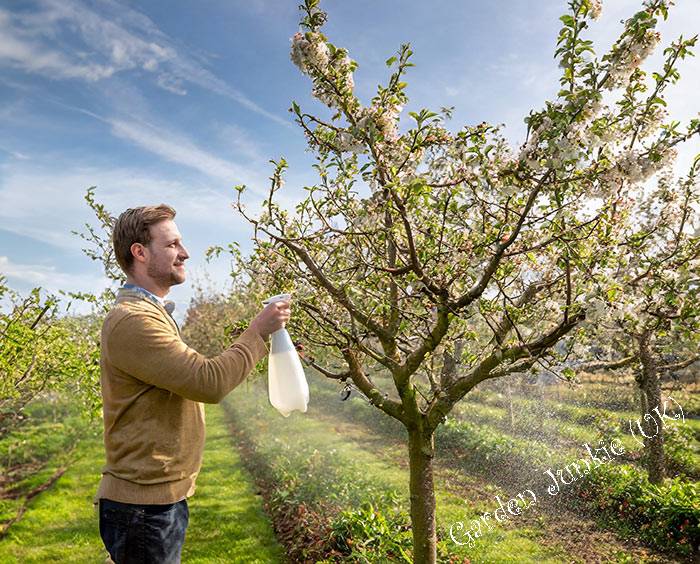
Gardening Month by Month – April: It’s a Great Time to Spray Your Fruit Trees. Watch Out For Capsid Bugs, Caterpillars And Other Pests.
In April: Pond Care
April Pond Care is much the same as March (so check out March as well) it’s just an extension of the jobs carried out in March with maybe a few extra things thrown in. April like March is generally about preparation. With the weather warming up, preparing your pond for the upcoming summer months is important as we mentioned previously.
This involves checking on your fish and any wildlife in the pond and garden, cleaning off stored equipment, balancing the chemicals in the pond, and pruning plants in readiness for the warmer weather.
- As the water temperature rises and fish begin to seek food, it’s important to clean and reinstall pumps, filters, and ultraviolet clarifiers previously removed over the winter. Before use though, ensure that any ‘stagnant water’ is flushed from the equipment to prevent issues with water quality.
- It’s a good idea to start ‘considering’ resuming fish feeding this month. Only start to feed your fish again when the ‘pond water temperature’ is consistently around 55°F (13°C). As the temperature increases, you may notice your fish coming to the surface of the pond in search of food. However, this behaviour can vary based on factors such as whether your pond is in shade or direct sunlight, as well as your location in the UK.
- During the early part of the season, your fish may not require feeding every day. It’s advisable to only provide them with an amount of food that they can consume within two to three minutes. Start them off with ‘Cold Water’ fish food as ‘Cold Water’ formulas move through your fish’s systems more quickly than summer food, which could sit in the fish’s stomach and cause problems if the fish aren’t ready to digest it.
- New fish can now be added to garden ponds, as long as care is taken to properly acclimate them to their new environment. This can be undertaken by ‘floating’ the fish together with the bag water in which they travelled in the pond to allow the water temperatures to equalise for around 30 minutes.
- It’s important to replace any ‘ultraviolet lamps‘ after a season’s use, even if they continue to emit light. These lamps over time, will age rapidly and become less effective at ‘killing algae’ in the pond. Take note of the wattage of your lamp to ensure you get the right replacement. Old bulbs may still glow but are far less effective and cost as much to run.
- Consider adding a bio-starter to your system to give filter bacteria a boost after the winter. This will help ensure that the right friendly bacteria are present to break down pollutants once the fish start to produce waste.
- If algae is a problem for you, it is best to address the ‘algae growth’ before it starts to take hold, consider adding barley straw pouches, phosphate controllers, and additional submerged plants.
- It’s common for other pond-related wildlife to start appearing in April, especially if you have a wildlife pond. During this time, the breeding season for frogs and toads is well underway. Typically, frogs breed first, laying clumps of jelly-like spawn at the edge of the pond. Following this, toads will commence breeding, with a tendency to spawn in larger ponds or return to an “ancestral” pond.
- As we are preparing for the summer, let’s not forget our pond plants. This will involve checking on all the plants you have in your ‘bog’ garden, planting baskets, or around any waterfall/s you may have.
- When checking each plant, be sure to inspect the base of the plant, as there may be little weed seedlings growing out of sight (yes pond plants have weeds just like the garden). Carefully dig around the weeds and remove them by hand, taking care to avoid damaging the plant.
- Continuing to prune your plants, both underwater and around the pond, is also important. Overgrown underwater plants can deplete too much oxygen at night, potentially impacting your fish. Similarly, oversized overwater plants may lead to withered leaves entering the pond and decaying, which can negatively impact the water’s ecology by forming sludge.
- Spring is the ideal time to split many of your pond plants. The Royal Horticultural Society website offers a useful guide for pond plant propagation. It’s also a good time to consider repotting your plants if they have outgrown their existing pots.
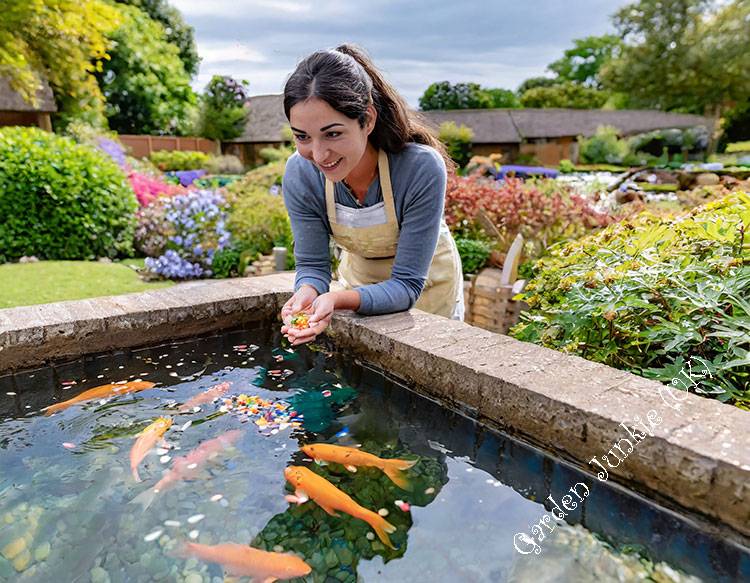
Gardening Month by Month – April: You Can Start to Feed Your Fish This Month. Just Keep an Eye on The Water Temperature
In April: General Garden Maintenance
April is an important time for general garden maintenance, including cleaning up the garden and preparing for the growing season. In the gardening calendar, there are always tasks to be done beyond planting, digging, pruning, and weeding.
- Why not look at attaching a gutter system to the greenhouse and set up a water storage container to collect rainwater, if you have not already done so allowing you to take advantage of any rainfall in April?
- On warm days, open the greenhouse doors and vents to enhance air circulation, or consider installing automatic vent openers for a more convenient solution.
- Ensure that the greenhouse glazing is clean to maximise natural light in the greenhouse.
- Ensure proper plant hygiene by removing any faded blooms and dead leaves to prevent the potential onset of fungal diseases.
- To address troublesome weeds like nettles and brambles, consider using a systemic herbicide or physically removing them by cutting and treating the regrowth.
- Continue providing food for birds, especially during this time when they are actively raising their young.
- April is the time to consider tasks such as repainting the shed, resealing your fence, or repairing/cleaning garden furniture in preparation for your summer season.
- Consider building or making a bug hotel with your kids to promote local wildlife and provide a fun and educational activity.
- Creating bird feeders or installing a bird bath can attract birds to your garden, offering natural pest control and enjoyable wildlife sightings.
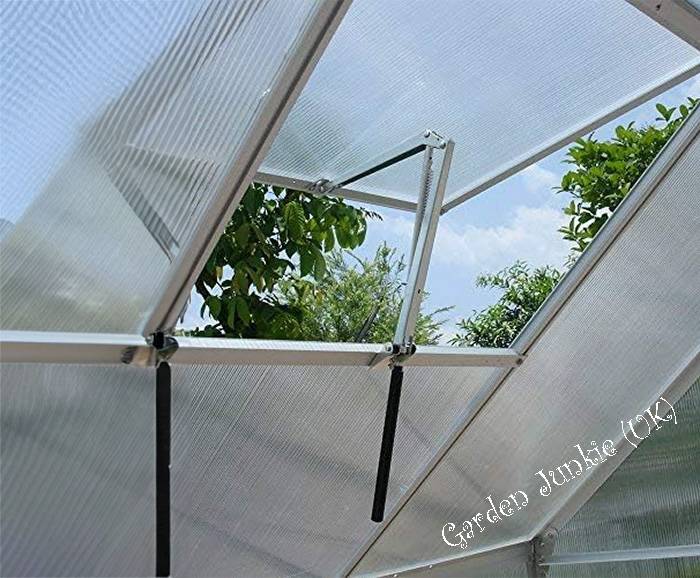
Gardening Month by Month – April: On Warmer Days Open Greenhouse Vents And Doors to Aid Ventilation or Consider Fitting an Automatic Vent Opener
FAQs
What Are Some Common Pests And Diseases to Watch Out For in The Garden During April?
In April, it’s important to be on the lookout for pests such as aphids, slugs, and snails, as well as diseases like powdery mildew and early blight.
Is it Advisable to Start a Compost Pile in April?
Yes, April is a great time to start a compost pile as the warmer temperatures help speed up the decomposition process. It’s important to balance the compost with a mix of green and brown materials,
When Should I Prune My Roses in April?
In most regions, April is probably the latest time to prune your roses, until late winter. Remove any dead or damaged wood, as well as cross branches, and shape the plant to promote healthy growth and abundant blooms.
